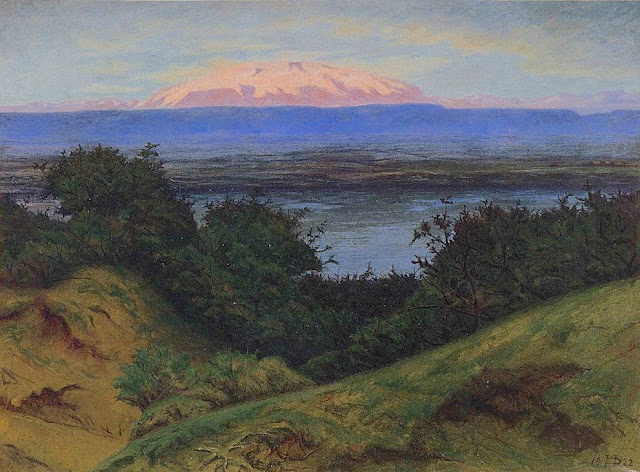In Herðubreið, oil on canvas, 1926
Biography of the painter
Sveinn Thórarinsson (in our alphabet Thorarinsson) and his wife Karen Agnete thórarinsson were both painters. Sveinn's parents were farmers in Kílakot (Iceland) but the family has maintained a strong tradition of artistic activities for several generations. Born in this very small and sparsely populated island that is Iceland, Sveinn Thórarinsson grew up, without knowing it, in a family that had a strong artistic reputation among its neighbors! His parents therefore brought him up naturally as an artist and in particular by making him play the violin like his father. Child, very puny, unable to compete with other adolescents in the work in the fields, he was sent to study music in the city. The music could therefore have occupied his mind completely, but it was not.
After successful studies in Reykjavik, he returned home and decided to paint while continuing to make music. He was suddently so active as a painter that people came to see his works from all the farms around! As his paintings were popular, he quickly became a renowned painter in Iceland, which was hardly surprising given the family he came from. For a long time he continued to play the violin and paint, at the same time, including frescoes in chapels drowned in snow. For several years, he painted and sold his works regularly, thus amassing a certain amount of money, which allowed him to face the wide world.
In the fall of 1925, he left to study at the Academy of Fine Arts.
Then his career as a painter, carried out mainly within his island, will carry him peacefully until his death.
Since then his price in the auction rooms has continued to rise and he appears as one of the great Icelandic painters of the twentieth century painting in a style which is very much inspired by that of Cezanne and the French impressions, which he knew mainly from books ...
The mountain
Herðubreið (1,682 m - 5,518 ft) meaning broad-shouldered is a tuya in northern part of Vatnajökull National Park, Iceland. It is situated in the Highlands of Iceland at the east side of the Ódáðahraun desert and close to Askja volcano. The desert is a large lava field originating from eruptions of Trölladyngja and other shield volcanoes in the area. Herðubreið was formed beneath the icesheet that covered Iceland during the last glacial period. The mountain is often referred to as "The Queen of Icelandic Mountains" by Icelanders due to its beautiful shape. Near the mountain lies an oasis called Herðubreiðarlindir with a campground and hiking trails. In former times, outcasts who had been excluded from Icelandic society because of crimes they had committed lived at the oasis. One such outlaw was Fjalla-Eyvindur, who lived there during the winter of 1774–1775. In 2019 Herðubreið became a part of Vatnajökull National Park.
___________________________________________
2021 - Wandering Vertexes...
by Francis Rousseau













